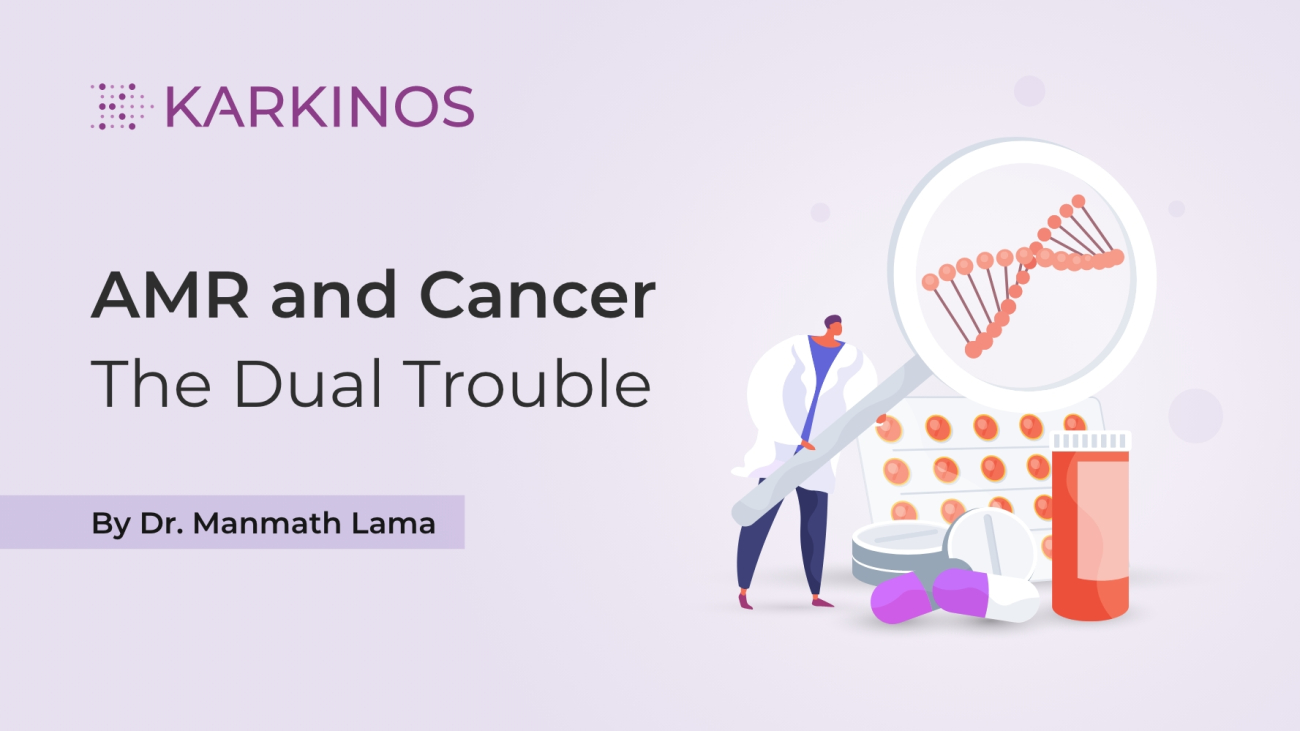Antimicrobial Resistance: The Global Crisis and Its Impact on Cancer Care
Dr. Manmath Lama, Program Executive, Bio Bank, Karkinos Healthcare
Antimicrobial Resistance: The Silent Pandemic
Antimicrobial agents are essential in fighting infections across various domains, such as humans, animals, and plants. These agents, including antibiotics, antivirals, antifungals, and antiparasitics, are effective against a wide range of microorganisms, from bacteria and viruses to fungi and parasites (1).
Despite their effectiveness, the increasing resistance shown by pathogens against these agents is a major concern because these microbes evolve rapidly and continuously giving rise to resistant variants (2). It is of utmost importance to recognize the grave threat posed by bacterial resistance, which greatly amplifies the danger of disease spread, severe illness, disability, and potential fatalities.
In 2019, a staggering 4.95 million global deaths were attributed to drug-resistant bacterial infections, with 1.27 million deaths directly linked to drug-resistant bacteria (3). Specifically in India, there were 297,000 deaths caused by drug-resistant bacteria, with an additional 1,042,500 deaths linked to these infections (4).
A study published in The Lancet warns that if left unchecked, by 2050 we could see over 10 million deaths per year solely due to drug-resistant bacterial infections – equivalent to the current global cancer death rate (3).
Evolution of Antimicrobial Resistance
The historical evolution of antimicrobial resistance traces back to Alexander Fleming’s accidental discovery in 1928 (5). Observing a zone of inhibition around a fungal growth on an agar plate, Fleming discovered Penicillium, leading to the isolation of penicillin — an antibiotic that earned him the Nobel Prize in 1945. This groundbreaking discovery revolutionized the treatment of bacterial infections, ultimately saving an estimated 200 million lives (6).
The concept of antimicrobial resistance (AMR) in bacteria can be divided into two main categories: intrinsic and acquired. Intrinsic resistance is a defense mechanism that is naturally present within the bacterial genome (7). It offers a basic level of protection that enables microorganisms to withstand the effects of antimicrobial agents to some extent. Unlike acquired resistance, intrinsic resistance is not directly influenced by selective pressures from antibiotic exposure but significantly contributes to the overall challenge of managing infections.
Conversely, acquired resistance develops in response to external pressures, such as prolonged exposure to antibiotics (2). It involves either mutations within the bacterial chromosomes leading to resistant mutants or the transfer of resistance genes within or between the species facilitated by mobile genetic elements like plasmids and transposons (8).
Dissemination of Resistance Genes
Notably, the spread of resistance genes, exemplified by MCR-1 (mobilized colistin resistance) and blaNDM-1 (New Delhi metallo-beta-lactamase), highlights the global nature of the crisis. MCR-1, first isolated from an animal farm in China in 2015, quickly made its way across borders and was found in a patient in Pennsylvania within a matter of months (9).
Similarly, the blaNDM-1 gene, originating in New Delhi in 2008, rapidly spread to countries such as Croatia, UK, and the US (10). This highlights the alarming ability of these genes to spread across geographic boundaries.
Bacteria’s Dual Role in Cancer Onset and Therapeutics
Various studies emphasize the strong link between bacteria and cancer, portraying them as both contributors to cancer initiation as well as potential allies in therapeutic innovations. Helicobacter pylori, for instance, has been associated with an increased risk of gastric cancer, as it can colonize the stomach lining and induce persistent inflammation (11). This prolonged inflammatory response may contribute to the development of cancerous lesions over time. Similarly, some strains within the gut microbiome have been implicated in promoting colorectal cancer by disrupting the body’s balance and fostering abnormal cell growth (12).
Conversely, researchers are harnessing the unique attributes of bacteria to pave the way for innovative cancer treatments. Engineered bacteria are being explored as carriers for controlled drug release, capitalizing on their heightened adhesion to cancer cells, improved targeting capabilities, and enhanced penetration into the cellular environment (13). This enables precise and targeted delivery of therapeutic agents to cancer cells while minimizing damage to healthy tissues.
These strategies represent an exciting frontier in cancer therapy, offering the potential for more effective and selective treatments with reduced side effects. However, the looming threat of antimicrobial resistance (AMR) poses potential challenges to these advancements.
Impact on Cancer Care
The weakened immune system of cancer patients undergoing chemotherapy greatly increases their vulnerability to drug-resistant bacterial infections, such as Acinetobacter baumannii, Staphylococcus aureus, Escherichia coli, and Pseudomonas aeruginosa (14,15). These drug-resistant bacteria can cause persistent infections, leading to increased concern among oncologists about the effectiveness of chemotherapy in these patients.
According to a study, the situation is dire as it reveals that a startling 88% of cancer patients who have died from hospital-acquired infections were infected with strains of bacteria that are resistant to multiple antibiotics (16). The absence of a strategic plan to combat these resistant pathogens jeopardises initiatives that are aimed at reducing cancer-related mortality.
The excessive use of antibiotics to combat infections in cancer treatment can increase the risk of bacteria developing antimicrobial resistance (AMR), creating a precarious scenario where a lack of proper prevention and treatment can significantly escalate cancer morbidity and mortality rate (17).
As drug-resistant strains proliferate, the arsenal of available antibiotics diminishes, limiting treatment options for cancer-related infections. This not only compromises the success of cancer treatment but also increases the duration and complexity, potentially affecting patient outcomes.
Cancer patients undergoing surgical procedures face formidable treatment challenges due to AMR, which increases their risk of postoperative infections and compromises the effectiveness of life-saving treatments (18).
The heightened susceptibility of cancer patients, who frequently visit healthcare facilities and endure extended hospital stays, pose an increased risk for drug-resistant bacterial infections. This susceptibility not only affects individual health but also has a significant impact on the economy, due to prolonged hospital stays and associated healthcare costs. Immediate efforts must be taken to combat the escalating threat of AMR in cancer management in order to maintain the efficacy of medical interventions in cancer patients.
Conclusion
Addressing the escalating threat of AMR is crucial. Despite the launch of a global action plan (19), the challenge persists due to varying levels of adoption by countries. Implementing a comprehensive strategy, involving continuous monitoring, responsible antibiotic utilization in hospitals, and intensified research and development, is of utmost importance. This is particularly crucial in vulnerable populations such as cancer patients, considering the severe impact that AMR can have on them.
References
1. Antimicrobial resistance. https://www.who.int/news-room/fact-sheets/detail/antimicrobial-resistance.
2. Munita, J. M. & Arias, C. A. Mechanisms of Antibiotic Resistance. Microbiol. Spectr. 4, 10.1128/microbiolspec.VMBF-0016–2015 (2016).
3. Murray, C. J. L. et al. Global burden of bacterial antimicrobial resistance in 2019: a systematic analysis. The Lancet 399, 629–655 (2022).
4. The burden of antimicrobial resistance (AMR) in India.
5. Keefer, C. S. Penicillin: Its Practical Application. Alexander Fleming. (Ed.) Philadelphia: Blakiston, 1946. Pp. x + 380. (Illustrated.) $7.00. Science 104, 558–558 (1946).
6. profile. Everything You Need To Know About Penicillin. https://www.nesfircroft.com/resources/blog/everything-you-need-to-know-about-penicillin/ (2021).
7. Cox, G. & Wright, G. D. Intrinsic antibiotic resistance: mechanisms, origins, challenges and solutions. Int. J. Med. Microbiol. IJMM 303, 287–292 (2013).
8. Partridge, S. R., Kwong, S. M., Firth, N. & Jensen, S. O. Mobile Genetic Elements Associated with Antimicrobial Resistance. Clin. Microbiol. Rev. 31, e00088-17 (2018).
9. Smith, R. D. et al. Rapid identification of mcr-1-positive Escherichia coli from patient urine using a novel lipid-based MALDI-TOF-MS assay. Access Microbiol. 3, (2021).
10. Wei, W.-J., Yang, H.-F., Ye, Y. & Li, J.-B. New Delhi Metallo-β-Lactamase-Mediated Carbapenem Resistance: Origin, Diagnosis, Treatment and Public Health Concern. Chin. Med. J. (Engl.) 128, 1969–1976 (2015).
11. Wroblewski, L. E., Peek, R. M. & Wilson, K. T. Helicobacter pylori and Gastric Cancer: Factors That Modulate Disease Risk. Clin. Microbiol. Rev. 23, 713–739 (2010).
12. Gagnière, J. Gut microbiota imbalance and colorectal cancer. World J. Gastroenterol. 22, 501 (2016).
13. Fooladi, S., Rabiee, N. & Iravani, S. Genetically engineered bacteria: a new frontier in targeted drug delivery. J. Mater. Chem. B 11, 10072–10087 (2023).
14. Yusuf, K., Sampath, V. & Umar, S. Bacterial Infections and Cancer: Exploring This Association And Its Implications for Cancer Patients. Int. J. Mol. Sci. 24, 3110 (2023).
15. Paprocka, P. et al. Pseudomonas aeruginosa Infections in Cancer Patients. Pathogens 11, 679 (2022).
16. Perdikouri, E. I. A. et al. Infections Due to Multidrug-Resistant Bacteria in Oncological Patients: Insights from a Five-Year Epidemiological and Clinical Analysis. Microorganisms 7, 277 (2019).
17. The impact of antibiotic resistance on cancer treatment, especially in low-and middle-income countries, and the way forward – 2022. ReAct https://www.reactgroup.org/news-and-views/news-and-opinions/year-2022/the-impact-of-antibiotic-resistance-on-cancer-treatment-especially-in-low-and-middle-income-countries-and-the-way-forward/.
18. Bratti, V. F. et al. Scoping review protocol on the impact of antimicrobial resistance on cancer management and outcomes. BMJ Open 13, e068122 (2023).
19. Global action plan for the prevention and control of noncommunicable diseases 2013-2020. https://www.who.int/publications-detail-redirect/9789241506236.

 biology, holds a PhD from Sri Sathya Sai Institute of Higher Learning (SSSIHL), specializing in bacterial genomics.
biology, holds a PhD from Sri Sathya Sai Institute of Higher Learning (SSSIHL), specializing in bacterial genomics.